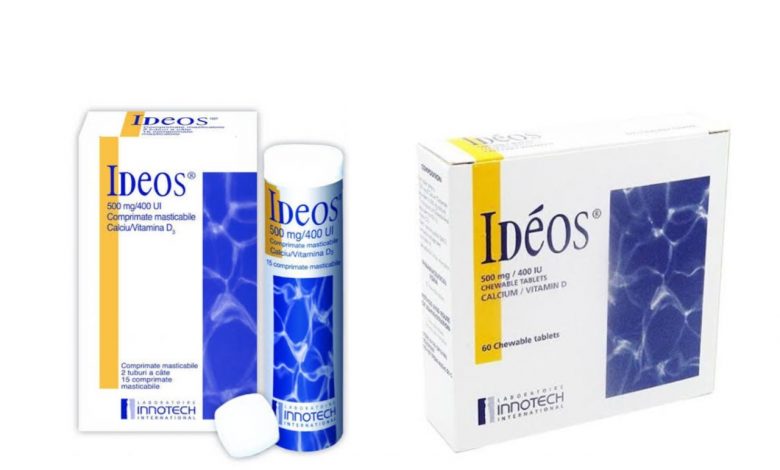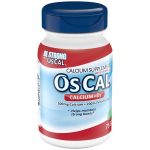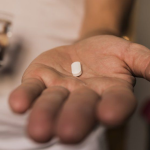IDeos: Uses, Benefits, Dosage, Side Effects, Interactions

IDeos chewable tablet is a nutritional supplement containing calcium and vitamin D used to treat Vitamin D or calcium deficiency, or in conditions such as osteoporosis, osteomalacia, and osteopenia.
Those most at risk from low levels of calcium include:
- people of childbearing age with amenorrhea
- people who do not consume dairy products, such as vegans or ovo-vegetarians
- people with lactose intolerance who avoid dairy
- post-menopausal people
Osteoporosis is a health condition that weakens bones, making them fragile and more likely to break. It develops slowly over several years and is often only diagnosed when a fall or sudden impact causes a bone to break (fracture). The most common injury in people with osteoporosis is a broken wrist.
Osteoporosis can occur in people of any age, but it’s more common in older adults, especially women. More than 53 million people in the United States either have osteoporosis or are at high risk of developing it.
People with osteoporosis are at a high risk of fractures, or bone breaks while doing routine activities such as standing or walking. The most commonly affected bones are the ribs, hips, and the bones in the wrists and spine.
Each tablet of IDeos contains 500mg Calcium and 400iu Vitamin D3. IDeos is produced by Innotech Laboratories International.
How it works
The two IDeos active ingredients work in synergy to promote bone health. Calcium is the major component of the bone, where it provides the skeleton strength and structure. Adults need the calcium in IDeos to maintain strong bones. Over time, inadequate calcium intake can cause osteoporosis, the brittle bone disease. People with osteoporosis are at high risk for broken bones, especially at the wrist, hip, and spin.
The second ingredient in IDeos is Vitamin D3 which is necessary for strong bones and muscles. Without Vitamin D, our bodies cannot effectively absorb calcium, which is essential to good bone health. Children who lack Vitamin D develop a condition called rickets, which causes bone weakness, bowed legs, and other skeletal deformities, such as stooped posture.
Before taking this medicine
Ask your doctor or pharmacist if Ideos is safe to use if you have:
• a parathyroid gland disorder.
• cancer;
• circulation problems; or
• heart disease;
• high levels of calcium in your blood;
• kidney disease;
• kidney stones;
Ask a doctor before using Ideos if you are pregnant or breastfeeding. Your dose needs may be different during pregnancy or while you are nursing.
How should I take IDeos?
Use exactly as directed on the label, or as prescribed by your doctor. Do not use in larger or smaller amounts or for longer than recommended.
The usual dose of IDeos is two tablets per day. However, your doctor may advise you to take less than this if necessary. Chew the tablet completely before swallowing. Then drink a glass of water. You must be aged over 18 years to use this product.
Benefits of IDeos
IDeos can prevent or treat low blood calcium levels in people who do not get enough calcium from their diets.
IDeos may be used to treat conditions caused by low calcium levels such as bone loss (osteoporosis), weak bones (osteomalacia/rickets), decreased activity of the parathyroid gland (hypoparathyroidism), and certain muscle diseases (latent tetany).
IDeos can also be used in certain patients to make sure they are getting enough calcium (including women who are pregnant, nursing, or postmenopausal, and people taking certain medications such as phenytoin, phenobarbital, or prednisone).
IDeos is rich in calcium which plays a very important role in the body. It is necessary for the normal functioning of nerves, cells, muscle, and bone. If there is not enough calcium in the blood, then the body will take calcium from bones, thereby weakening bones.
IDeos as a vitamin D source helps your body absorb calcium and phosphorus. Having the right amounts of vitamin D, calcium, and phosphorus is important for building and keeping strong bones.
What are the side effects of IDeos?
Common side effects of IDeos may include:
- Irregular heartbeat
- Weakness
- Drowsiness
- Headache
- Dry mouth
- Metallic taste in your mouth
- Muscle or bone pain.
IDeos can also cause serious side effects, get emergency medical help if you have signs of an allergic reaction: hives; difficult breathing; swelling of your face, lips, tongue, or throat.
Call your doctor at once if you have signs of too much calcium in your body, such as:
- Nausea
- Vomiting
- Constipation
- Increased thirst or urination;
- Muscle weakness
- Bone pain
- Confusion
- Lack of energy
- Feeling tired.
This is not a complete list of side effects and others may occur. Call your doctor for medical advice about side effects. You may report side effects to FDA at 1-800-FDA-1088.
What medications can interact with Ideos?
IDeos decrease the absorption of other drugs such as tetracycline antibiotics (for example, doxycycline, minocycline), bisphosphonates (such as alendronate), estramustine, levothyroxine, and quinolone antibiotics (such as ciprofloxacin, levofloxacin).
Furthermore, certain medications can decrease the absorption of IDeos and affect how it works (bile acid sequestrants such as cholestyramine/colestipol, mineral oil, orlistat).
When taking IDeos, separate your doses of these medications as far as possible. Ask your doctor or pharmacist about how long you should wait between doses and for help finding a dosing schedule that will work with all your medications.
Check the labels on all your prescription and nonprescription, herbal products (such as antacids, laxatives, and vitamins) because they may contain calcium, phosphate, or vitamin D. Ask your pharmacist about using those products safely.
Conclusion
The ingredients in Ideos play a crucial role in bone health and have several other health benefits. High levels of calcium and vitamin D in the body are rare and likely to come from excessive supplementation with Ideos. There are many dietary sources of calcium. The primary source of vitamin D is sunlight. People can obtain additional calcium and vitamin D from supplements like IDeos.
For IDeos safety concerns watch this video above





